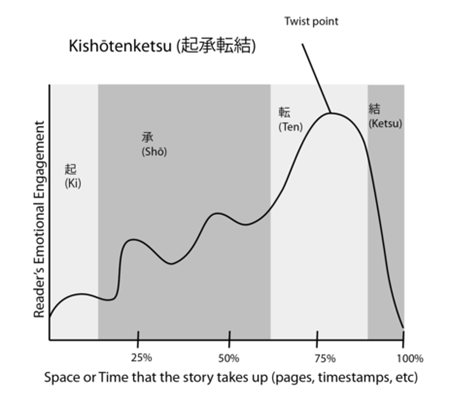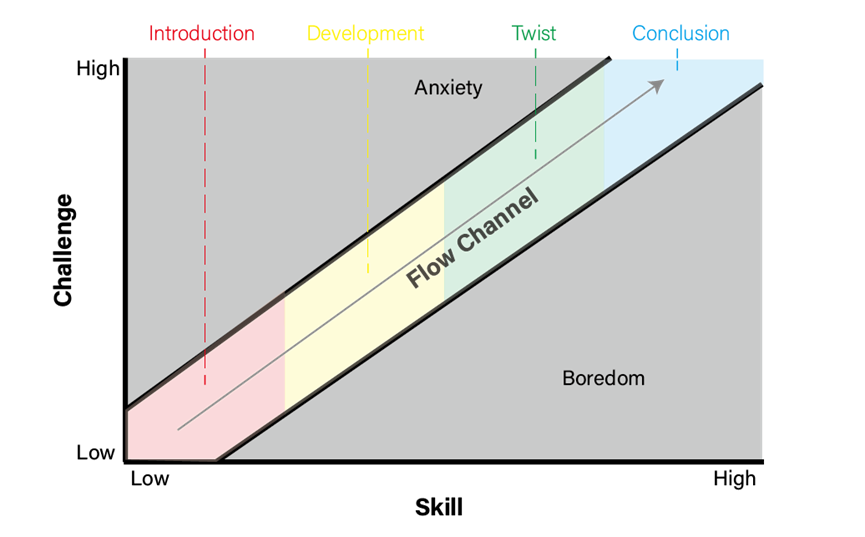Introduction
Kishōtenketsu is a narrative structure that originated from the Chinese Yuan Dynasty poetic style and is currently widely used in designing games (Wikipedia, 2022). This paper introduces the application of Kishōtenketsu in game design by giving examples and discussing its advantages for game design.
Keywords:Kishōtenketsu; Game Design; Narrative Structure
How Kishōtenketsu is used in games
Koichi Hayashida proposed the application of Kishōtenketsu in game design in 2002, where he divided individual game mechanics structure into the following four steps (Stilleatingoranges, 2012):
(1) Introduction of a new gameplay mechanic in a safe environment; (2) Development offers a slightly more complicated scenario to use the mechanic; (3) Twist which is using the mechanic in an unexpected way, and (4) Conclusion going through boss challenges with comprehensive use of this mechanic (Fig. 1 and 2).

Such a four-step structure is also widely used in the level design of Super Mario: Odyssey and the uproot challenge in the wooded kingdom can be a good example.
In the first stage, players first meet an uproot, a creature that can stretch many times its height forward. There is a safe area for players to explore freely, manipulating uproots to stretch, smashing bricks and tree fruit or attacking other uproots. In the second stage, more complex terrain appears, forcing players to learn skills such as jacking up panels, breaking bricks, and moving between complex platforms (Mariowiki, 2022). Players should follow the rhythm to stretch the uproot to get through this terrain. The third stage involves timely actions where players need to advance around a towering column to the top, paying attention to the appearance of greenery platforms while controlling jumps to avoid moving obstacles. And in the final stage, players are guided to use all the previous mechanics in the boss fight, which means they have to top off the bricks to break the boss and then give it a fatal blow.

Kishōtenketsu is not only reflected in Super Mario: Odyssey but also in numerous other games, such as The Legend of Zelda games, It Takes Two, etc. It is widely used in game design because it helps designers create mind-flow experiences and control the game-level pace.
Mind-flow Experience Shaping, Immersion Enhancement
The flow theory was originally developed by psychologist Mihaly Csikszentmihalyi, who believed that people who enter a state of mind flow become completely focused and immersed in their current activities and situations, experiencing a sense of accomplishment and forgetfulness (Cziksentmihalyi 1992). He proposed the original flow model, while Chen Sing-Han pointed out that flow in game design only needs to encapsulate three important elements: the balance between player ability and challenge, the sense of control, and the sense of satisfaction (Sing-Han, 2006).
First, players are introduced to the mechanic at a minimum, while low-level challenges and safe environments are configured for players to explore on their own to stimulate their curiosity. In this stage, players' skills and challenges are at a low level.
Second, players are guided to explore and gain proficiency in skills by breaking through mandatory instructions and barriers in the scenario, corresponding to the middle part of the mind-flow model.
Third, players are given a series of tasks in a new direction, and they are asked to actively think about it from a fresh perspective. In this stage, players’ skills and challenges both rise to new heights.
The final stage verifies the players' ability through boss battles, when both players' skills and the difficulty of challenges reach their peak, corresponding to the final stage of the mind-flow model.
Aligning with the flow theory, the Kishōtenketsu structure divides the level into four stages, in which players' skills and the difficulty of the challenge increase simultaneously so that players can intuitively and clearly feel their own growth and thus more easily reach the state of mind flow (Fig. 3).

Level Pacing Control, Freshness Maintenance
Compared to introducing players to all the gameplay applications at once, Kishōtenketsu theory assists the designer in gradually showing players the application scenarios of the new mechanics and even stimulates their desire for active exploration. At the same time, it shortens the time it takes for players to adapt to the new mechanism, focusing instead on each new application scenario in steps until they finally encounter the boss battle, where they need to combine all the previous skills to complete the comprehensive test.
For example, in the first stage, uproot, and its manipulation methods are introduced; then, in the second stage, new organs (such as blocks, bricks, etc.) and various rewards are introduced; in the third stage, players are guided to discover the floating time difference possessed by uproot and use it to pass the time-limited puzzle; The last stage aggregates all the previous application scenarios and merges them in the same boss design. Therefore, by adopting such a level design law, designers can better split the level design, master the progress and rhythm, and avoid a certain part of the experience from being too long or too short. At the same time, it allows players to constantly receive new ideas, avoiding the boredom caused by simply repeating and experiencing the same application scenario and keeping the players' freshness and desire to explore the game.
Conclusion
This paper introduces Kishōtenketsu, a widely-used level design structure that breaks down the introduction of new mechanics into four steps within a level. This paper also analyzes the advantages of this level design structure by using the example of Super Mario: Odyssey, which can shape the mind-flow experience and keep the players fresh. In the future, as the game world evolves and the gameplay mode iterates, the evolvement of the new level design structure and continuous development of the current structure would advance gaming industry.
Reference
Csikszentmihalyi, M. (1992). Flow: The Psychology of Optimal Experience. Journal of Leisure Research, 24(1), 93-94. https://doi.org/10.1080/00222216.1992.11969876
Mariowiki. (2022). Uproot. ps://www.mariowiki.com/Uproot
Sing-Han, C. (2006). Flow in game. Welcome to flow in games. http://www.jenovachen.com/flowingames/
Stilleatingoranges. (2012). The significance of plot without conflict. https://stilleatingoranges.tumblr.com/post/25153960313/the-significance-of-plot-without-conflict
Wikipedia. (2022). Kishōtenketsu. https://en.wikipedia.org/wiki/Kish%C5%8Dtenketsu